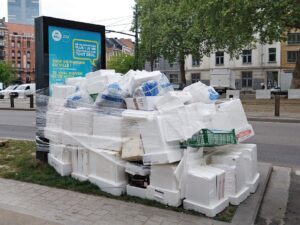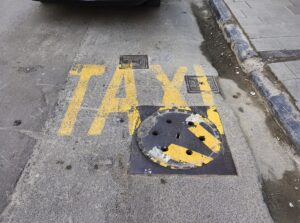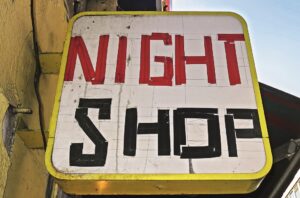If Rome is the open-air museum of ancient times, Paris the open-air museum of the 19th century and New York the open-air museum of the 20th century, then Brussels is the open-air museum of the last five minutes. Wherever you look, someone has just added or done something to the city. Left a trace or wiped it out. Made a plan and then ignored it.
Here, a superfluous no-parking sign has been transformed into a one-way street sign by construction workers using brushes and paint. There, a staircase has been left standing that ends at a wall. Night stores improvise their own typeface with sticky tape as if they will be disappearing again tomorrow. A traffic light, which has lost its lower half after an accident, is plonked back into the ground at shoulder level.
Belgian Solutions
After I arrived in Brussels 20 years ago, it took a while before I gradually became aware of the frequency of such occurrences. At one point I could no longer not see it, yet nor could I simply walk past it without capturing it.
By 2007, with social media emerging, I had an outlet. I gave it the title “Belgian Solutions”, which was open enough to be neither too critical nor too affirmative. More like a homage and a wink at the underlying creativity.
It is also a guide to the thinking behind seemingly lifeless objects and situations. For the past 15 years, people from all corners of the country have been sending me their own discoveries. Thousands of my photos meet thousands of other photos. Belgian Solutions has become a mailbox.
A few years ago, I also published two books with about 300 photos each (Belgian Solutions - Volume 1 & Volume 2 by Luster, Antwerp. Spoiler alert: a third is in the pipeline), that made it into the collection Photobook Belges: 1844 - Now (FOMU, Hannibal). At one point, the project generated international media attention, with reports in newspapers on TV and on radio. An exhibition of prints is travelling around the country. I still manage daily submissions on Instagram and Facebook from some 50,000 followers.
People recognize the phenomenon. One walks through Brussels as through the halls of a museum displaying historical artefacts. From small sculptures (taped house number repairs) to structural concepts (the entire traffic light system), you find it all. The books catalogue this nationwide exhibition.
The exhibits are more than just local curiosities. They are an attitude. Nothing has any meaning until we give it one. The question is, who gives it meaning? And should we even wait for this meaning to be given? Belgians don’t wait. They give meaning to things instinctively. They make sense of it. Even if the absurdly contradictory meanings often suggest otherwise.
Solutions, not fails
The key to understanding the solutions here is the intention: to solve something. They might be a response to an accident, a mishap or even a situation that is not a problem, but they are always a proposed solution. The humour that inevitably arises when discovering the situation is not mockery. Rather, it is the joy that arises when you try to imagine the crude creative process behind the ugly solution.
When I see these improvised gems, I invent dialogues that might have preceded the solution:
"Oh, crap: the detour goes to the left. Now we have to go…”
“…back to the storeroom to pick up the right signs? I don't think so.”
Or:
“We still have to remove the staircase.”
“Who says this is a staircase? It might as well be a bench.”
In Belgium, the traces of on-the-spot decision-making are integral to the urban environment and even the architecture. But is that typically Belgian? Are there other places with this attitude? Undoubtedly. People everywhere spend look for solutions and answers to problems big and super small, invented and real.
However, the way these solutions come together, and the way they come to light or are banished to obscurity, can shape the image of a city or a country.
My argument is that Belgium has its own brew. A quirky mix of over-bureaucratisation and self-organisation. A nationwide attitude on the border between top-down and bottom-up, where the doer decides what something looks like. Not anarchy, but rather a simultaneity of self-entitlements. However, I do wonder if the underlying aesthetics of Belgian solutions are the expression of their unvarnished functionalism, or if we can read it as a kind of ornamentation.
Solutions to solutions
My concept has even led to its own solutions, meta-solutions if you want. A few years ago, King Philippe and Queen Mathilde visited a venue in the town of St Vith where my Belgian Solutions photo exhibition was on display. Fearing any potential offence to the royal couple, the city council took my work down for that day.
The twist of this solution was that they did not change the spotlights. It meant the later press photos showed the king and the queen together with a children’s choirs and officials in a space with absurd lighting pointing to empty spots on the background walls.
In another recent case, a marketing agency copied one of my pictures for a campaign to promote Flemish cheese. When I asked why they hadn't contacted me before, I received the following solutionist reply:
"Dear Mr Helbich, These illustrative pictures are not own creations, but observations of existing situations. Therefore, at best, the rights to the idea belong to the government or road builders or other institutions that created these situations."
Brilliant: a copyright on Belgian solutions. Of course, this was beautiful nonsense. But the effort to solve a possible conflict was impressively creative.
Here and now
I called Brussels the open-air museum of the last five minutes because we seem to shuffle back and forth into the future. We are constantly creating a city by correcting it. And then correcting the correction. Time in Brussels is not linear, at least not in a progressive sense. For 20 years, I have tried to predict the big changes, but looking back, nothing seems substantially different – although nothing is the same as it used to be.
In a sense, this temporality, this provisional status, is a permanent condition. No one is cleaning up for eternity here, no design relates to its direct environment or collective aesthetics. To paraphrase the philosopher Hegel: the parts relate to the whole as if the whole is only one of the parts.
When I take a picture, I look for the thoughts that someone had in that situation. It must show a certain ambition. Not for eternity, but for the here and now of the doer. I love the eternal stacking and overlapping of all here-and-nows. The clash of decisions. The togetherness of individualists.
Newcomers to the city are often confused. They can't read the situation. Is it an over-bureaucratic city? Or just totally chaotic? Is it boring or whacky? Is Brussels beautiful or is this yet to come? It is hard to see. You almost need a degree in anthropological archaeology to peel off the layers of human intervention embedded in Brussels. These are traces of idiosyncratic decisions over and under traces of organisation.
The confusion is compounded by a very particular kind of identity. In other cities, it often feels that residents or visitors can be a slice of a big and complex identity pie, as long as they integrate. In Brussels, identity is more like a cookie jar, and we are the cookies. A jar full of different tastes and ingredients. And you are one of them.
This is, of course, a dream for young artists, as I was when I arrived in Brussels in 2002. Nothing is more inspiring than a multi-identity biscuit jar. Brussels is an invitation to add something to the chaos.
Art and folklore
One definition of conceptual art is that the artworks are just examples of the concept. In this case, the artwork is the title of my project. Belgian Solutions is both right and wrong, generous and nasty, ironic and honest.

It's a wrap
It has become part of conversations all over Belgium, sometimes translated as “Les solutions belges” or “Een belgische oplossing.” It is even a hashtag, #belgiansolutions. The dream of a conceptual artist is to change language itself, so this is very satisfying.
But more importantly, it is a tool. It works like an exclamation mark: look, a solution! Or a warning: don't let it become a Belgian solution! (A politician actually said that during the last coalition negotiations).
This collection of photos, especially those sent in by other solution spotters, deserves to be recognized as part of Belgium's cultural heritage. It is a contemporary contribution to Belgian folklore. And it is positive proof, if you needed it, that people here can laugh at themselves.





